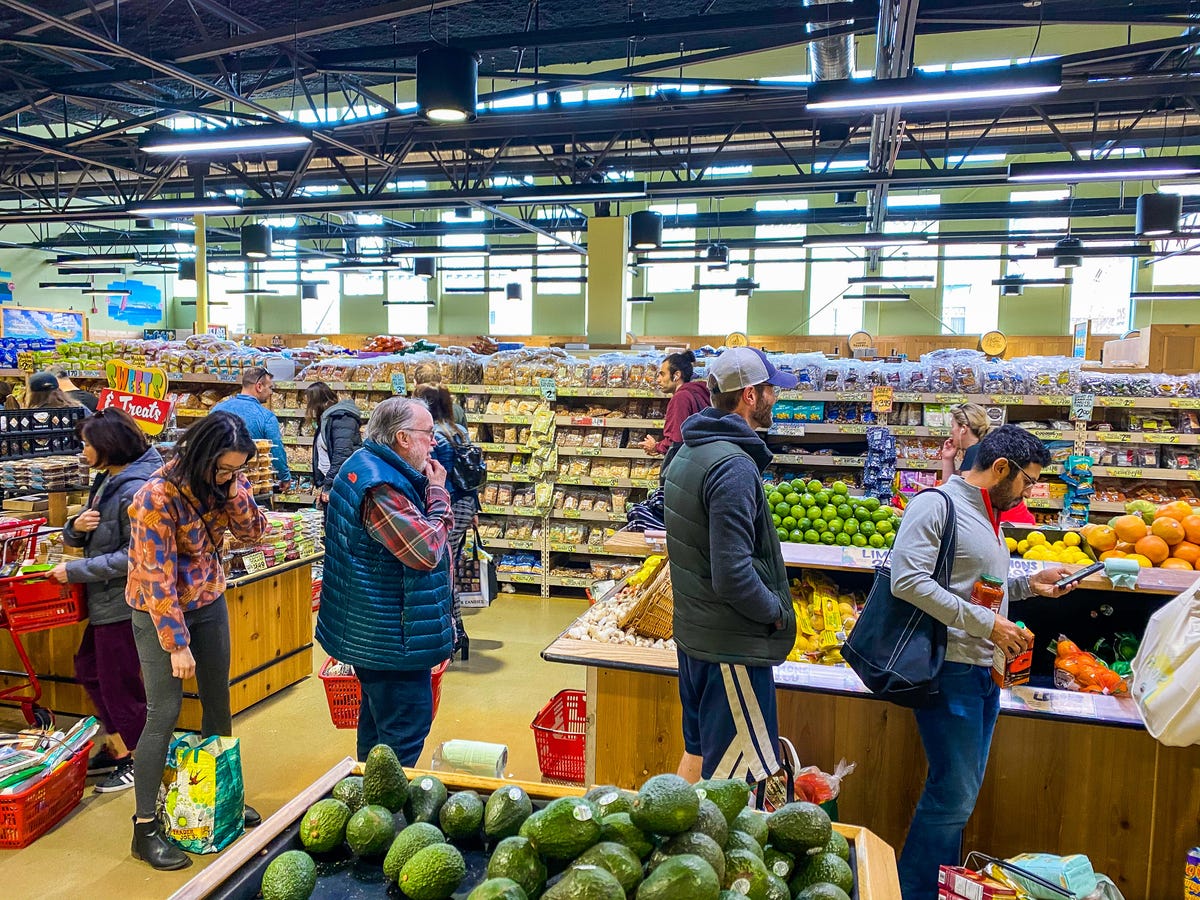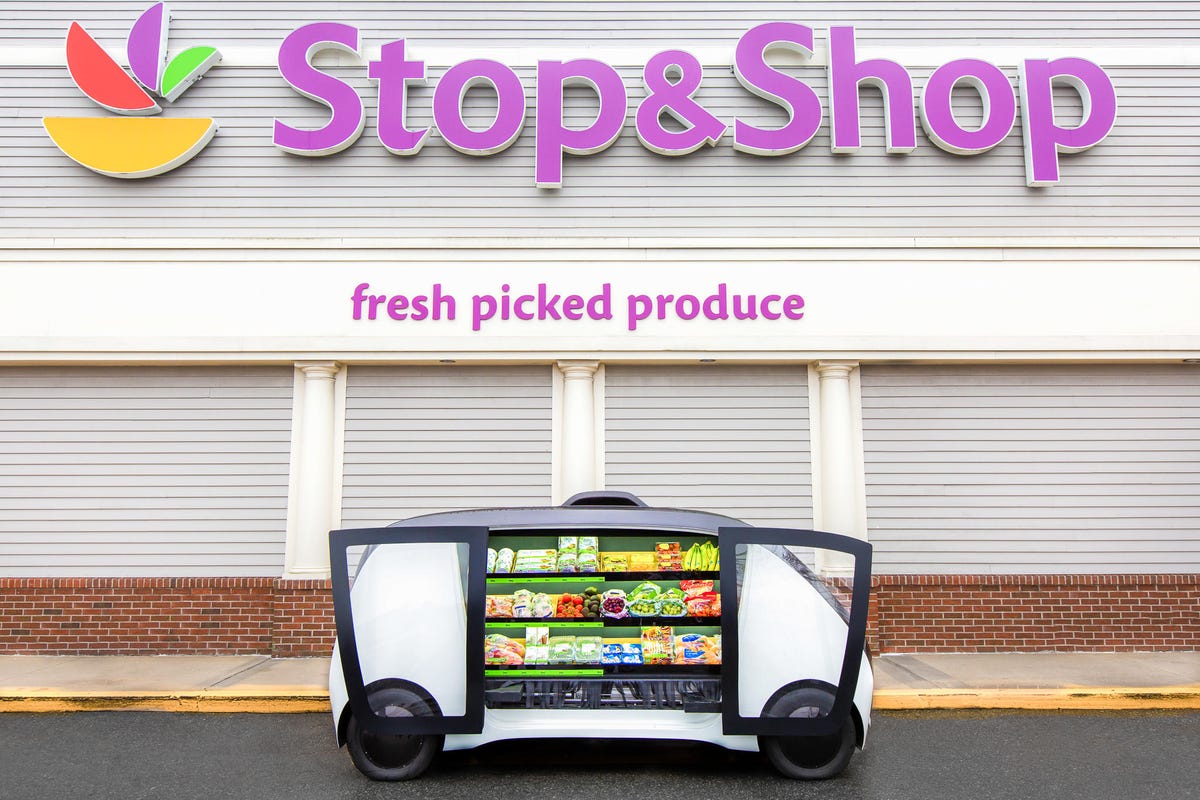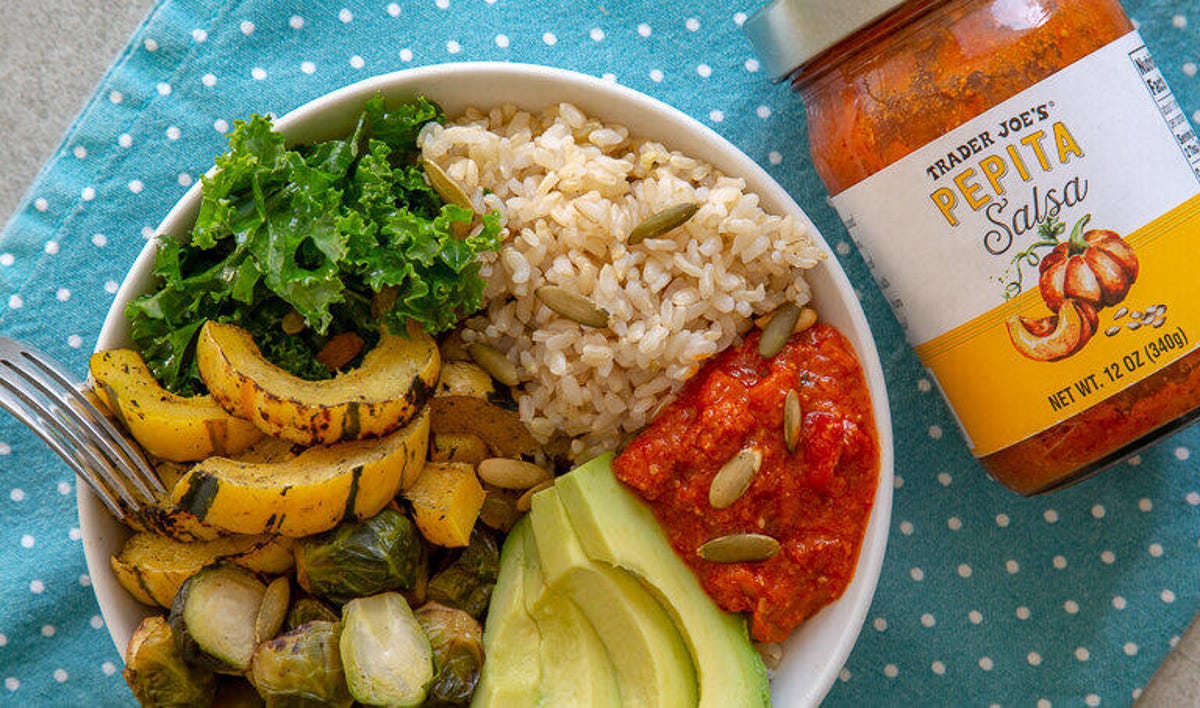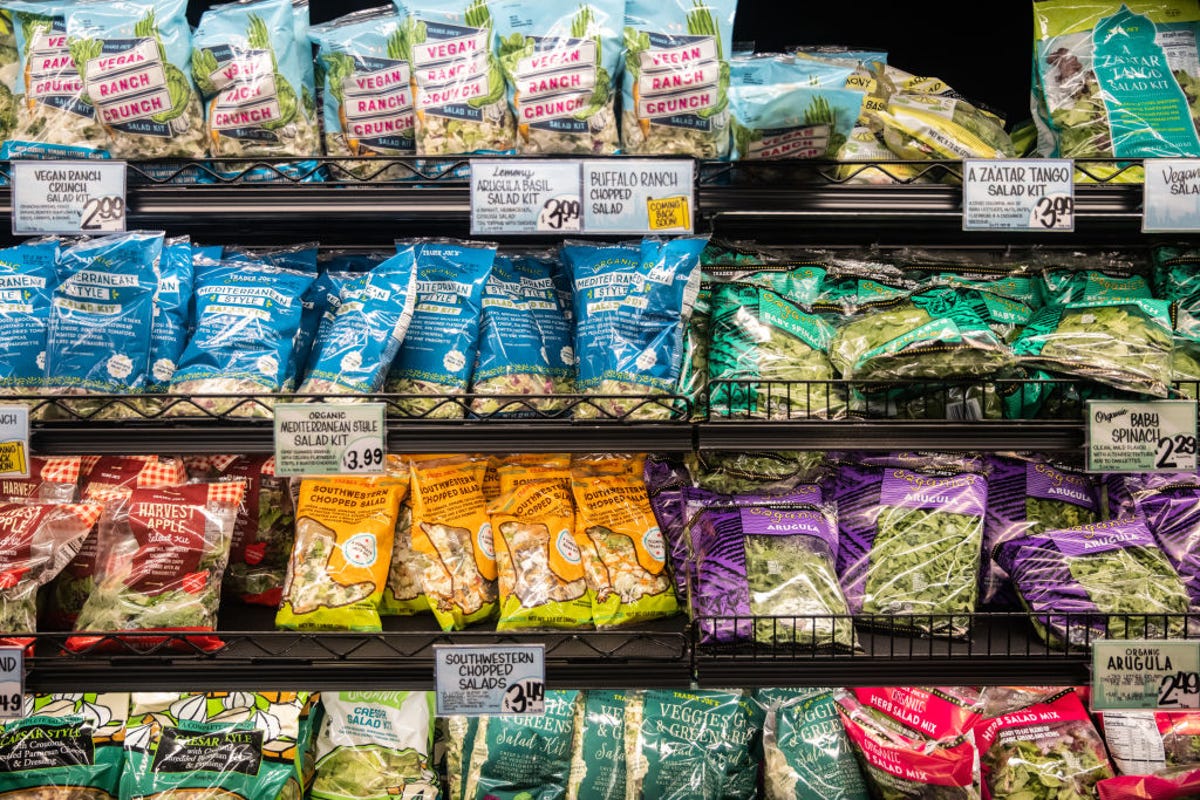Trader Joe’s has an army of fans who come in droves for the exclusive food items, quirky employees (they really do seem happy) and cheap groceries. But are Trader Joe’s groceries really as good of a deal as they seem? As a professional food writer and semi-professional deal hunter, I wanted to get to the bottom and see how much I could save shopping at Trader Joe’s.
After pricing out a full 48-item grocery list at Trader Joe’s against a typical supermarket, the savings were clear and, honestly, even bigger than I expected. In the end, my purchase from TJ’s netted out to be roughly 33% cheaper than the competition.
Here’s the full breakdown of how much I saved shopping at Trader Joe’s.
For more price comparisons, check out how much you can save by shopping at Costco, if it’s cheaper to buy meal kits than groceries and if shopping for groceries online is less expensive than in the store.
Trader Joe’s vs. Stop & Shop
| Product | TJ’s | Stop & Shop |
|---|---|---|
| Baby spinach, 6oz | $1.99 | $3.99 |
| Fresh herbs (variety), 1oz* | $1.69 | $2.29 |
| Head of cauliflower, each | $2.99 | $3.49 |
| Red bell pepper, each | $1.29 | $2.29 |
| Banana, each | $0.19 | $0.41 |
| Beefsteak tomato, each | $1.29 | $1.40 |
| Hass avocado, each | $1.49 | $1.99 |
| Italian extra virgin olive oil, 33.8oz* | $5.99 | $8.29 |
| Honey O’s, 13.5oz | $2.29 | $7.19 |
| Organic unsweetened soy beverage, 32 oz | $1.99 | $4.19 |
| Classic potato chips, 10oz* | $2.49 | $5.29 |
| Tortilla chips, 10oz^ | $2.49 | $3.39 |
| Roasted red pepper hummus, 10oz | $3.49 | $4.99 |
| Shredded mild cheddar cheese, 12oz* | $3.49 | $3.19 |
| Cream cheese, 8oz | $1.69 | $2.89 |
| Sliced Muenster cheese, 12oz* | $4.49 | $3.79 |
| Greek nonfat yogurt, 32oz | $5.49 | $5.79 |
| Organic 2% milk, half gallon | $3.79 | $5.69 |
| Half and half, 1 quart | $2.69 | $5.19 |
| Unsweetened applesauce, 24oz | $1.99 | $3.19 |
| Creamy salted peanut butter, 16oz | $2.29 | $2.59 |
| Whole bean coffee, 14oz* | $4.99 | $8.39 |
| Whole roasted and salted cashews, 16oz^ | $7.99 | $16.49 |
| Organic low sodium chicken broth, 32oz | $1.99 | $3.19 |
| Solid white albacore tuna in olive oil, 5oz | $2.29 | $2.59 |
| Organic virgin coconut oil, 16oz* | $4.99 | $14.69 |
| Garbanzo beans, 15oz | $0.89 | $1.19 |
| Black beans, 15oz | $0.89 | $1.19 |
| Whole grain Dijon mustard, 12.3oz* | $1.99 | $3.79 |
| Grade A 100% maple syrup, 8oz | $4.49 | $9.69 |
| Clover honey, 12oz | $3.99 | $6.29 |
| Spaghetti, 16oz | $0.99 | $1.49 |
| Unbleached all-purpose flour, 5lbs | $2.99 | $3.69 |
| Frozen peas, 16oz | $1.59 | $3.49 |
| Chopped frozen spinach, 16oz | $1.49 | $3.49 |
| Frozen pepperoni pizza, 15oz^ | $5.99 | $7.89 |
| Multigrain waffles, 11oz^ | $2.49 | $3.29 |
| Large brown eggs, 1 dozen | $3.29 | $4.19 |
| Frozen cheese tortellini, 10oz^ | $2.49 | $5.19 |
| 15% lean ground beef, 16oz | $5.99 | $5.49 |
| Fresh Atlantic salmon, 16oz | $9.99 | $14.99 |
| Ground turkey, 16oz | $3.99 | $5.49 |
| All natural whole chicken, per pound | $3.99 | $3.99 |
| Plain bagels, 6 count, 18oz | $1.99 | $4.39 |
| English muffins, 6 count, 12oz | $1.99 | $1.99 |
| Flour tortillas, 8 count, 15.5oz | $2.99 | $2.09 |
| French vanilla ice cream, half gallon | $6.49 | $3.79 |
| Fresh pizza dough, 16oz | $1.49 | $3.49 |
| Total | $150.32 | $227.45 |
| *indicates that Trader Joe’s item was of a larger size | ||
| ^Indicates that Stop & Shop item was of a larger size |
Who supplies Trader Joe’s products?
First things first. In understanding the potential cost savings of shopping only at Trader Joe’s, it’s important to know where TJ’s products come from, whether we’re speaking of flour and butter or Unexpected Cheddar and Butter Chicken. Having previously brought you an analysis of store brand versus name brand products and finding massive potential savings in the grocery receipts, is it simply a matter of Trader Joe’s only selling store brand items? That is: Trader Joe’s more or less only sells products under its own brand name, with few exceptions.

Trader Joe’s is definitely cheaper than the average grocery store, but you might have to wait in a longer checkout line to take advantage of them.
Trader Joe’s isn’t actually a manufacturer unto itself, and unlike some store brands, which are just name brands in disguise, Trader Joe’s relationship with its vendors is a unique point in understanding its pricing structure. Turns out there’s actually merit to the “trader” element of Trader Joe’s, which, according to its website, deals directly with manufacturers and growers, and cuts out the brokers and distributors, contributing to its lower-seeming prices. Which exact vendors make those Trader Joe’s items with cult-like followings is a closely guarded secret.
Trader Joe’s vs. Stop & Shop
Stop & Shop is a regional chain in the northeastern US whose sibling companies include Hannaford, Giant and Food Lion. I chose Stop & Shop to represent an average grocery chain in my available area whose reputation is good and whose prices are known for being reasonable, but which doesn’t have the cult following of Trader Joe’s, or even certain other conventional retailers such as Wegmans. Stop & Shop does have its own store brand, which is simply called SB, which stands for “store brand.” (No points for originality there, Stop & Shop.) It also has an organic store brand line called Nature’s Promise. Both the SB and Nature’s Promise brands offer a wide variety of products in every department.

Your local Stop & Shop may have self-driving delivery pods but it also has significantly higher grocery prices than Trader Joe’s.
How I evaluated Trader Joe’s and Stop & Shop for staples
Using grocery shopping templates available online, I generated a list of 48 basic grocery items representing a wide range of price points from nearly all food and drink departments in October 2022. For each item, I compared the Trader Joe’s price, sourced from an in-store visit in Queens, New York, to the Stop & Shop price, sourced from Instacart. (For Stop & Shop items that are typically sold by weight, Instacart offers an estimated price per piece.)
I tried to find equivalencies in terms of the sizes of each product but noted where one store or the other was offering a larger size. I didn’t scale the prices accordingly, however, since I wanted the end totals to reflect the actual prices you’d find on your grocery receipts. To make it as fair a fight as possible, and since Trader Joe’s entire fleet of products qualifies as store-brand, wherever possible I used the equivalent Stop & Shop SB or Nature’s Promise product as a point of comparison.

Trader Joe’s beloved pepita salsa is just one example of a store brand item that’s gained fandom and loyalty all its own.
Trader Joe’s savings are still huge
At the end of the nearly 50-item list of basic staples, comparing what was effectively store brand to store brand, Trader Joe’s clearly came out as the winner, totaling only $150.32 to Stop & Shop’s $227.45, for a total of about 33% savings on the entirety of the list. If you’re someone who doesn’t typically purchase store brand items when shopping at conventional grocery stores, it is safe to assume that the potential savings would be even greater, easily approaching a 50% discount compared with similar brand name products.
Where are the biggest savings on Trader Joe’s items?
Almost all of Trader Joe’s biggest money savers come from the pantry department, with cereal, soy milk, coffee, maple syrup, coconut oil and nuts amounting to more than 50% off of the Stop & Shop price. Coffee and coconut oil, in particular, have such untouchable prices, one wonders whether TJ’s has brokered a deal with the devil himself.
It is worth noting that deli cheeses seemed to be the one category where Stop & Shop came close to TJ’s. Stop & Shop’s prices for both shredded cheddar cheese and sliced Muenster cheese were actually lower than the same TJ’s products. In both cases the sizes offered by Stop & Shop were smaller, however, giving TJ’s an advantage in terms of value, but it stands to reason that for items with shorter shelf lives, such as cheese, the smaller package might be a more advantageous purchase anyway.

Cheese and produce are two departments where Trader Joe’s may not always have a clear price advantage.
Additionally, the produce department at Trader Joe’s is almost entirely sold by package or by item (as opposed to by weight), with prices that rarely fluctuate, meaning that there might be better produce deals to be found at conventional retailers for fruits and vegetables that are priced by weight rather than the piece, and based on seasonality. (When spotted, I will always buy a 99 cent avocado at any retailer.)
I would also note that weekly sales specials, which were not necessarily factored in here, can also offer a conventional retailer a price advantage over Trader Joe’s on certain items from week to week. Despite these possibilities for occasional better savings in some departments, however, the math is clear: Trader Joe’s has some of the best overall prices, even where basic groceries are concerned.
This story was originally published in October 2022.
FAQs
What grocery store did we use as the point of comparison with Trader Joe’s?
We used Stop & Shop prices as the direct comparison to Trader Joe’s. The difference between prices for Stop & Shop items and Trader Joe’s items is how we generated the results used in this article. Your mileage may vary when comparing Trader Joe’s prices to other grocery stores.
Why are Trader Joe’s items so cheap?
Trader Joe’s has a unique relationship with manufacturers, allowing them to cut out the middleman in the supply chain — TJ’s is then able to pass some of those savings on to you, the consumer, as they sell their products at a lower overall price.























+ There are no comments
Add yours